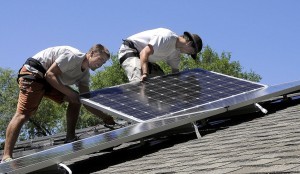By Kimbersee Kruesi /Associated Press
Eli Lucero/Herald Journal
BOISE, Idaho (AP) — Idaho Power said Thursday it wants permission from state regulators to lump people who install rooftop solar panels starting next year into a new class of energy providers, and may ask later for permission to charge them more money than current solar producers pay to access the state’s power grid and buy electricity when their panels are not producing.
The utility’s request could significantly change the system that compensates users of rooftop solar panels and other renewable sources for their excess electricity. Idaho Power said it needs clearance from the commission to create a whole new customer class before discussing possible rate hikes.
“We want to continue offering this service,” said Tim Tatum, Idaho Power’s vice president of regulatory affairs. “We are seeing rapid growth, so now is the time to have this conversation.”
At issue is a practice called “net metering,” a system first created in 1983 requiring homeowners and small business owners who install solar panels to be compensated for any surplus energy they feed back onto the grid. It’s a practice largely regarded as a key incentive for solar and other renewable energy customers.
Idaho Power’s move follows a national trend of many other states also considering changing net metering policies as usage in the system has exponentially increased.
According to the U.S. Energy Information Administration, net-metered solar saw significant growth in 2015, adding over 2,100 megawatts in generation capacity. This is the fourth consecutive year of annual growth above 50 percent.
About 1,400 Idahoans are enrolled in the system, primarily with rooftop solar panels. But Idaho Power has said the current system was not designed to account for homeowners who installed their own solar panels — resulting in traditional power customers being forced to make up any budget shortfalls.
The “time has come to take gradual, yet meaningful, steps toward establishing rate designs and compensation structures for customers with on-site generation that are fair and sustainable into the future,” Tatum wrote in his testimony to the utilities commission.
Under the proposal submitted Thursday, current net metering customers would be grandfathered into their existing rates for hooking into the electrical grid and buying power when they are not producing it. Any new customers producing their own solar power would be funneled into the pending new class as of Jan. 1.
If approved, Idaho Power would then ask the commission for further permission to subject those customers to potentially new fees or a higher rate structure.
Renewable energy advocates criticized the move.
“Idaho Power isn’t showing their hand,” said Wendy Wilson, executive director of the Snake River Alliance. “They’re setting up a second class of customers but they’re not saying what rules those customers will face. This will cast a large cloud on the future of solar in Idaho.”
Idaho Power already charges customers $5 per month for access to the grid even if no power is used, Wilson said. If that’s not enough to cover the costs of the grid then the rates should be adjusted for all customers.
Wilson added that customers who produce power should receive regular retail rates because the power generated via solar or other renewable sources improves the overall electrical grid and lowers the need to buy power at peak times of demand.





